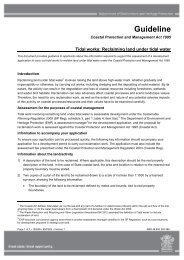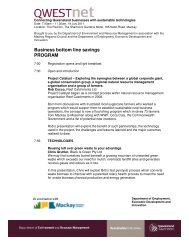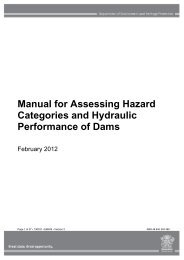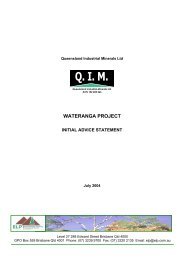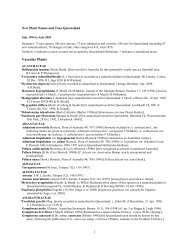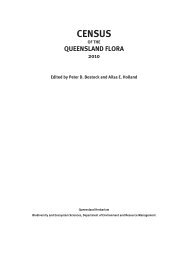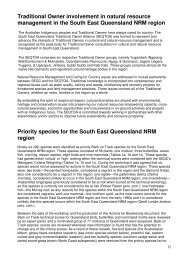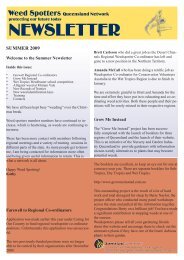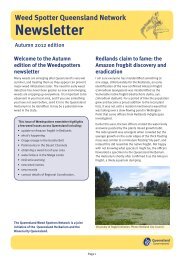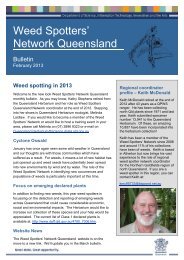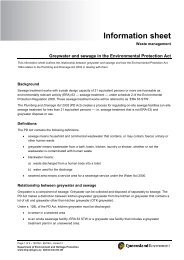Enhancing Biodiversity Hotspots Along Western Queensland Stock ...
Enhancing Biodiversity Hotspots Along Western Queensland Stock ...
Enhancing Biodiversity Hotspots Along Western Queensland Stock ...
Create successful ePaper yourself
Turn your PDF publications into a flip-book with our unique Google optimized e-Paper software.
Introduction<br />
<strong>Queensland</strong>’s <strong>Stock</strong> Route Network (SRN) is a web of stock routes, roads and<br />
reserves for travelling stock that covers most of the State. This network is a rich<br />
inherited legacy that has far greater benefits than just the movement of livestock,<br />
which was and still is their primary role.<br />
The stock routes were formally recognised between the 1860s and 1890s, although<br />
human usage of these routes goes back much earlier. Aboriginal trade routes had<br />
traditionally followed the best hunting trails and permanent watering sites, so it is little<br />
wonder that indigenous knowledge was sought to survey for pastoral settlement and<br />
movement of livestock when the stock routes were established. This pragmatic<br />
approach resulted in the retention of some of our best biodiversity sites throughout<br />
the SRN of western <strong>Queensland</strong>, including dry season water holes which are the<br />
refugia for aquatic life in a land of pulsing seasons.<br />
As this network stretches from the <strong>Queensland</strong> border with New South Wales to the<br />
Gulf of Carpentaria, it supports a diverse range of threatened species and habitats<br />
from springs of the Great Artesian Basin, to Brigalow woodlands, to the tropical rivers<br />
of the Gulf country. Further evidence of the biodiversity value of the stock routes,<br />
their connectivity, and remnant vegetation, is illustrated by the number of National<br />
Parks and Conservation Reserves that either have stock routes connecting with the<br />
park, or dissecting them completely (such as Diamantina National Park and Hell Hole<br />
Gorge). In total, this amounts to 28 National Parks and two Bush Heritage<br />
Conservation Reserves in the four Natural Resource Management (NRM) regions of<br />
<strong>Western</strong> <strong>Queensland</strong>. There are also 55 declared State Forests which are in some<br />
way connected to stock routes.<br />
Under the Land Protection (Pest and <strong>Stock</strong> Route Management) Act 2002, the<br />
administration of the SRN is shared between local Government and the Department<br />
of Environment and Resource Management (DERM) (formerly the Department of<br />
Natural Resources and Water and the Environmental Protection Agency). Local<br />
government is responsible for day-to-day management, while DERM is responsible<br />
for providing the framework of legislation and policy for stock route management and<br />
support for local governments. As not all of the SRN is currently used to move stock,<br />
stock routes are classified into either active (primary, secondary and minor) and inactive.<br />
The values of the SRN of western <strong>Queensland</strong> are under threat from multiple<br />
pressures that include inappropriate grazing regimes, feral animals and weeds. Due<br />
to the vast scale of the area, and high costs of management, current management of<br />
the stock routes is highly fragmented. Additionally, a low appreciation of the multiple<br />
assets of the SRN has limited the willingness of managers to protect their values.<br />
It is not possible to manage this entire network equally due to its scale, nor would<br />
that be necessary because of the habitat fragmentation across the landscape from a<br />
history of human impacts. However, by identifying biodiversity hotspots, and<br />
recommendations for their management, it would be possible to direct management<br />
of the SRN to conserving the most significant biodiversity values while maintaining<br />
the primary purpose of the network, which is the movement of stock<br />
In order to achieve this, this project was initiated by a consortium consisting of<br />
DERM, the four Natural Resource Management bodies of <strong>Western</strong> <strong>Queensland</strong> –<br />
Southern Gulf Catchments (SGC), Desert Channels <strong>Queensland</strong> (DCQ), South West<br />
7



